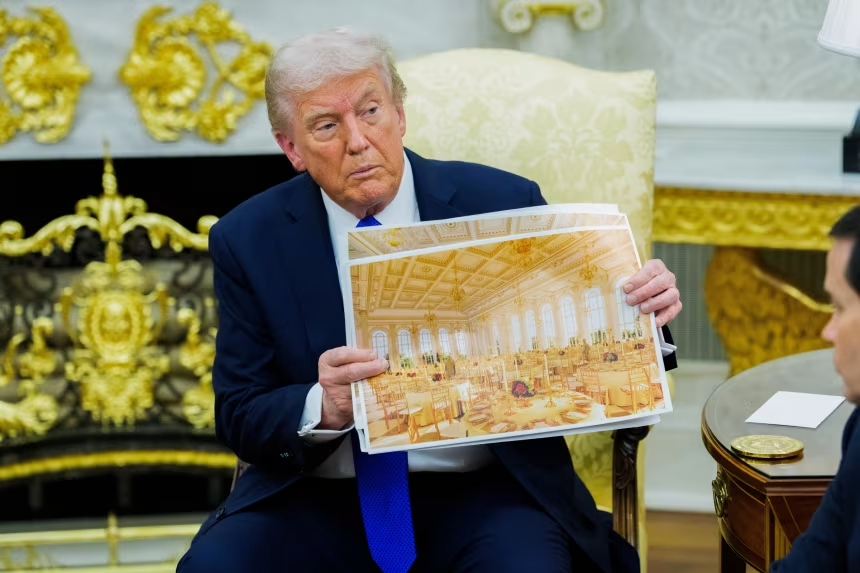Washington, D.C. — In a development stirring both curiosity and controversy across political and corporate circles, several of America’s largest and most influential companies — including Apple, Amazon, Lockheed Martin, Microsoft, Google, Coinbase, Comcast, and Meta — have reportedly made donations toward the construction of President Donald Trump’s proposed 90,000-square-foot ballroom at the White House complex.
According to a statement released by the White House, the expansive ballroom is part of Trump’s larger vision to “restore grandeur and functionality” to the nation’s executive residence. The president has repeatedly emphasized that the project will not cost taxpayers a single dollar, insisting it is privately funded by himself and a circle of wealthy donors and corporate partners.
A $300 Million Project to “Honor American Legacy”
Speaking at a press conference on Wednesday, President Trump shared new details about the ballroom project, which he described as “a symbol of America’s greatness and unity.” He confirmed that the estimated cost has grown to “about $300 million,” up from the previous $200 million estimate announced earlier this year.
“This ballroom will be one of the most beautiful and functional spaces in the world,” Trump said. “It’s going to host historic events, state dinners, and moments that will define the next century of American leadership.”
While Trump highlighted the architectural significance of the structure, critics have raised questions about corporate influence and the blending of political and business interests. The White House, however, maintains that the donations are entirely voluntary and comply with all existing ethics and transparency laws.
Who’s Funding the Project?
The list of donors reads like a who’s who of American industry and finance. In addition to major tech giants and defense contractors, notable individual contributors include Tyler and Cameron Winklevoss, co-founders of the cryptocurrency exchange Gemini; Commerce Secretary Howard Lutnick and his family; and the Adelson family, longtime Republican donors and owners of the Las Vegas Sands Corporation.
The Adelson family’s involvement has drawn particular attention given their long-standing ties to Trump and the Republican Party. Miriam Adelson, widow of late casino magnate Sheldon Adelson, was awarded the Presidential Medal of Freedom by Trump in 2018 — the nation’s highest civilian honor.
White House officials have suggested that additional names will be released as the project moves forward, though several donors have already expressed pride in their contributions. A spokesperson for Amazon described the donation as “a commitment to supporting American history and diplomacy,” while a representative for Meta stated that the company was “honored to contribute to a project that celebrates national culture and unity.”
A Grand Vision — or a Grand Distraction?
The ballroom, planned to sit adjacent to the White House’s existing East Wing, is expected to feature marble flooring, gold-trimmed chandeliers, advanced sound systems, and retractable seating for over 1,500 guests. According to preliminary renderings, the space will include state-of-the-art facilities capable of hosting both domestic and international events, from state banquets to official summits.
Supporters of the project view it as a legacy-building initiative that will enhance America’s image on the global stage. They compare it to France’s Palace of Versailles or Britain’s Buckingham Palace in its intent to reflect national prestige.
However, critics argue that the timing and scale of the project are questionable, especially amid concerns about economic recovery and federal spending priorities. “It’s difficult to justify a $300 million ballroom when so many Americans are still struggling,” said Democratic strategist Maria Gonzalez. “Even if it’s privately funded, the symbolism feels tone-deaf.”
Ethics Questions and Political Implications
Ethics watchdogs have already called for closer scrutiny of corporate donations linked to the project, noting potential conflicts of interest between the White House and businesses that frequently engage with the federal government. Companies such as Lockheed Martin, which rely heavily on government defense contracts, could face particular attention.
“The issue isn’t just who’s donating — it’s why,” said Dr. Alan Schreiber, a political ethics expert at Georgetown University. “When corporations contribute to projects tied directly to the president’s personal legacy, the line between philanthropy and influence becomes blurred.”
Still, Trump’s team insists that every dollar is being handled through a transparent and legal framework. A senior administration official told reporters that all funds are being managed through a dedicated trust, separate from campaign or government accounts.
Construction Timeline and Future Use
The ballroom is currently in the design and planning phase, with groundbreaking expected to begin in early 2026. Once completed, the space will be used for official White House events, international summits, and ceremonial gatherings, as well as public tours on select occasions.
President Trump has hinted that the project could also serve as a “lasting testament” to his administration’s achievements, comparing it to the Eisenhower Executive Office Building in both function and symbolism.
“We’re building something that future presidents will use for generations,” Trump said. “This is about history, elegance, and pride in America.”
The Legacy Question
Whether the new ballroom becomes a celebrated symbol of American tradition or a lightning rod for political criticism remains to be seen. What’s clear is that Trump’s vision — powered by some of the world’s most powerful companies — has already reignited debate about the intersection of wealth, politics, and national identity.
As plans move forward, the White House ballroom project stands as one of the most ambitious and polarizing private construction efforts in modern presidential history — a grand reflection of Trump’s enduring belief in spectacle, scale, and legacy.

